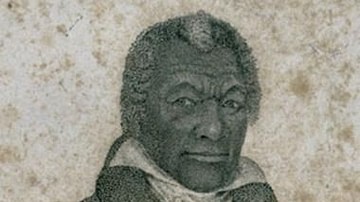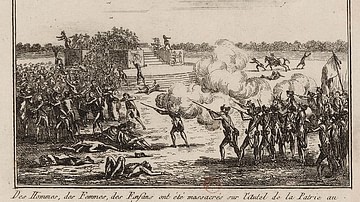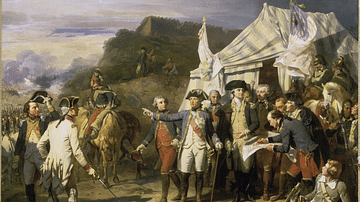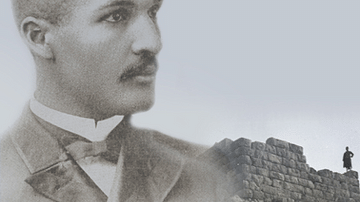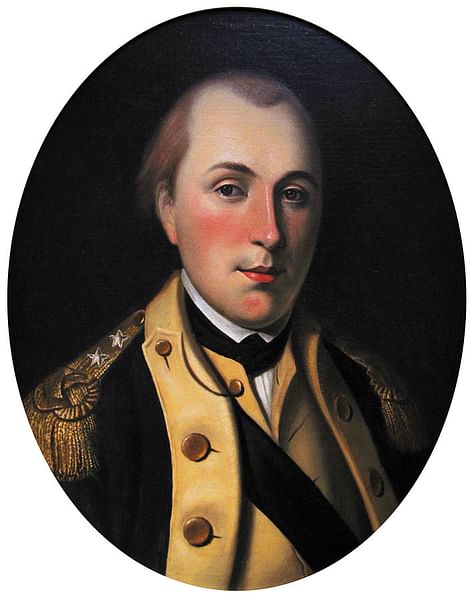
Marie-Joseph Paul Yves Roch Gilbert du Motier, Marquis de La Fayette (l. 1757-1834), more commonly known in the United States as simply Lafayette, was a French aristocrat, military officer, and politician. He was a major figure in both the American and French revolutions, helping to shape the destiny of both countries.
At the age of 18, he left France against explicit orders from the king to fight the British in the American War of Independence (1775-1783), where he quickly rose through the ranks to become one of George Washington's most trusted generals, commanding American forces during significant campaigns such as Yorktown.
After returning to France, his zeal for republican ideals led him to become an important figure in both the French Revolution (1789-1799) and the July Revolution of 1830. He was instrumental in drafting the Declaration of the Rights of Man and of the Citizen in France, modeled on the U.S. Declaration of Independence, and helped steer France through one of its most difficult periods. His involvement in the revolutions of both the United States and France earned him the nickname "the Hero of the Two Worlds" (Le Héros des Deux Mondes).
Early Life
Lafayette was born on 6 September 1757 at the Château de Chavaniac, an austere, fortress-like estate in Auvergne, about 500 km (300 mi) south of Paris. The rather militant design of the family chateau perfectly reflected the La Fayette family's military tradition, stretching back to the founding of the family by one Pons Motier, who was granted the fiefdom of Villa Faya around 1000. In 1250, a La Fayette served under Louis IX of France (r. 1226-1270) during the Sixth Crusade and allegedly seized the Crown of Thorns. In 1428, Gilbert III de La Fayette, marshal of France, rode alongside Joan of Arc at the legendary Siege of Orleans. The most recent warrior prior to Lafayette's own time was his father, who, at 27, served as a grenadier colonel during the Seven Years' War, where he was killed by a British cannonade at the Battle of Minden in 1759. The elder Lafayette's death left his son with the title of marquis, at the age of two.
Listening to such tales of glory, Lafayette naturally began to yearn for adventures of his own. As he would later describe of his childhood, he fancied himself something of a Vercingetorix, "defending the mountains of Auvergne", and would later write of his childhood that he remembered nothing more than his "fervor for tales of glory and my plans to travel the world in quest of fame" (Unger, 7). He also developed another quality that would prove no less important in his career: a love for the commoners and liberty. From a young age, he cultivated a fondness for the peasants around Auvergne, who were devoted to his family since Lafayette's aunt allowed them to hunt in their woods and gifted them the surplus foodstuffs that her own family did not need. When Lafayette was enrolled in the prestigious military school the Collège du Plessis, he became exposed to enlightenment ideas that only increased his passion for liberty.
In 1770, while Lafayette was in Paris as a cadet in the prestigious Black Musketeers, his mother and grandmother died within weeks of one another, leaving him an annual income of 120,000 livres. This newfound wealth, as well as his high status as a Black Musketeer cadet who took riding practice alongside King Louis XV of France's own grandsons, made him one of the most eligible bachelors in Paris. For these reasons, he caught the eye of the duc d'Ayen, an influential noble from the famous de Noailles family. D'Ayen believed that 14-year-old Lafayette would be an ideal match for his 12-year-old daughter Adrienne and began making marriage arrangements, taking a personal interest in continuing Lafayette's education. In 1774, they were officially wed, and the marriage contract was signed both by Louis XV (r. 1715-1774) and the Dauphin, who would be crowned King Louis XVI of France (r. 1774-1792) less than a month later. Looking to advance his son-in-law's career, d'Ayen enlisted Lafayette in the elite Noailles Dragoons.

Revolution in America
After Great Britain's 13 American colonies asserted their independence, the fledgling United States knew it needed foreign support if it hoped to win a war against one of the world's foremost powers. As part of their efforts, American diplomats in Paris looked to enlist French officers to take commissions in the Continental Army in return for training American soldiers. Lafayette jumped at the chance, but the British soon uncovered the plan and threatened to consider France in a state of war, should the officers be allowed to depart. The government of Louis XVI issued a decree forbidding any French officers from adventuring in the Americas, on penalty of imprisonment. Lafayette, whose status as a Musketeer and close ties to the French court at Versailles marked him of special interest, was explicitly mentioned by name in the king's decree.
Lafayette was sent to London, where he met with important British officials, including King George III (r. 1760-1820). He still intended to go to America, wishing to "right the wrongs of the last war, to fight the English and to fly to the aid of the Americans" (Auricchio, 31), and the 19-year-old marquis slipped out of France aboard the ship Victoire, without a word to his family to avoid arousing suspicion. After an arduous cross-Atlantic voyage, he set foot in Charleston in June 1777 and made his way to Philadelphia to receive his promised commission. Congress was reluctant, however, as they had seen an influx of foreign officers beyond expectation, many of whom lacked real experience and spoke little English. Although Lafayette himself had yet to see a battle, he managed to win Congress over with his enthusiasm and his status as a Freemason, and he was given the rank of major general.
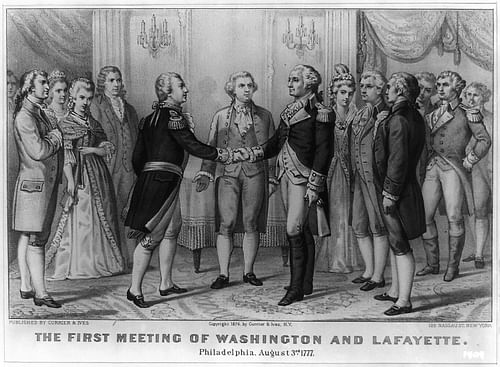
It was in Philadelphia that Lafayette first met George Washington (l. 1732-1799), commander-in-chief of the Continental Army. Lafayette was immediately taken by Washington's demeanor, seeing in the Virginian aristocrat the virtue of the Roman Republican heroes he admired. When Washington first introduced the young Frenchman to the American army's camp, the general expressed embarrassment at how his own ragged force must look to an officer straight from the French army. Lafayette responded: "I came here to learn, not to teach" (Unger, 41). The two men quickly formed a bond, and Lafayette found in Washington a lifelong friend and father figure.
Lafayette had his first taste of combat on 11 September 1777 at the Battle of Brandywine Creek, where he was wounded in the left calf while trying to rally fleeing American soldiers. He spent less than two months recovering, before returning to the field, victoriously leading 300 soldiers against a superior Hessian force at Gloucester. He remained fiercely loyal to Washington, staying by the general's side at Valley Forge until ordered to mount an invasion of Canada, a command he refused to accept unless he acted beneath Washington's authority. Although the planned invasion never materialized, in the winter of 1777 Lafayette managed to meet with the Six Nations of the Iroquois in upstate New York, going so far as to win the Oneidas over to the American cause. The Oneidas were so impressed with the young Frenchman that they bestowed upon him the name Kayewla, or "fearsome horseman".
As the American Revolutionary War wore on, Lafayette continued to serve in increasingly important roles, commanding divisions at significant battles such as at Monmouth Court House and Newport. He became a popular figure in the United States, becoming fast friends with many soldiers, members of Congress, and Founding Fathers. Back in France, tales of his heroism in America were widespread, and he was raised to somewhat of a celebrity status, especially after France officially joined the war on the side of the Americans in 1778.
Spending the year 1779 back in France, Lafayette helped organize the French forces that would be sent to America, while also planning a daring invasion of Britain itself, which ultimately never occurred. In 1781, Lafayette was leading an army in Virginia, engaged in a game of cat and mouse with a British army led by Lord Cornwallis (l. 1738-1805). Lafayette trapped Cornwallis in the trading port of Yorktown and managed to hold him there until Washington could arrive by land while a French navy blockaded the port from the sea. Cornwallis surrendered on 19 October, and this was one of the last significant conflicts of the war. The Treaty of Paris of 1783 saw the United States' independence, and Lafayette returned to France.
Revolution in France
After being reunited with his wife and three children back in Auvergne, Lafayette worked to establish stronger Franco-American ties, advocated for the rights of French Protestants, and argued for the abolition of slavery. In the meantime, the late 1780s found France in a steadily increasing state of chaos, facing a financial crisis, large-scale unemployment, and widespread famine. National unrest continued to worsen until 1789 when Louis XVI was forced to convene the Estates General for the first time in 175 years.
The Estates General was a legislative and consultative assembly, comprised of the three different estates, or classes, of French subjects: the clergy, the nobility, and the commoners. Each estate received only one vote, and so the first two estates, which represented only ten percent of the population and often voted together, could always outvote the third estate, which represented the other 90 percent. To counter this, Lafayette proposed convening a national assembly instead, where each individual would have a single vote, but this was initially shot down.
The Estates General met in Versailles on 5 May 1789, with Lafayette elected as a representative for the second estate. Although the original topic of discussion was supposed to be taxation, the conversation quickly dissolved into arguments regarding the Estates' compositions, specifically about the imbalance of power. After more than a month's deliberation, with royalists failing to bring the conversation back to taxes, the third estate, with some support from individual members from the other estates, declared themselves a National Assembly.
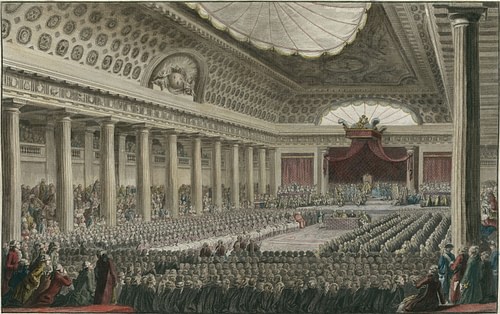
They invited the other estates to join them but declared their intent to conduct national policy with or without them. The enraged royalists responded by using soldiers to bar the members of the National Assembly, including Lafayette, from entering Versailles, prompting the members to swear an oath in the royal tennis court to not disband until a constitution could be established.
Seeing this as an opportunity to bring his beloved American ideals to his birth country, Lafayette met with his friend Thomas Jefferson (l. 1743-1826), and together they produced the first draft of what would become the Declaration of the Rights of Man and Citizen. The declaration proclaimed the natural rights familiar to Enlightenment ideals including the idea that men are born free and equal, and that all men have the inalienable rights to liberty, property, safety and resistance to oppression. Yet, even as Lafayette was finishing the draft, things continued to escalate in Paris. On 14 July, the very day the National Assembly met to consider the declaration as a preamble to their new constitution, the Bastille was stormed.
The next day, facing chaos and disorder in the streets of Paris, the National Assembly appointed Lafayette to the command of the newly formed National Guard, charging him with keeping order in the city. Lafayette took his new role seriously, training the men under his command to the best of his ability. He outfitted them with cockades that combined the red and blue colors of the revolution with Bourbon white, hoping to demonstrate the Guard's commitment to both the people and the crown. This symbol would later become the tricolor of France.
As he cracked down on street crime, he simultaneously lobbied the Assembly to reorganize the government into a constitutional monarchy, which would allow Louis XVI to retain the throne, while also introducing republican principles to France. However, this middle ground made Lafayette many enemies; royalists viewed him as a dangerous revolutionary trying to overthrow the monarchy, while radicals like the Jacobins felt he was not going far enough to help the people. To Lafayette, keeping law and order was the most important thing, and in 1790, he helped organize the Fête de la Fédération, a massive holiday festival held in honor of the Revolution. On the Champ de Mars, in front of 350,000 Parisians, Lafayette led the crowd in an oath swearing allegiance to the nation, the law, and the king. This was perhaps the height of Lafayette's popularity, a time when his grip over the city led him to write to a friend, "I reign in Paris" (Auricchio, 193).
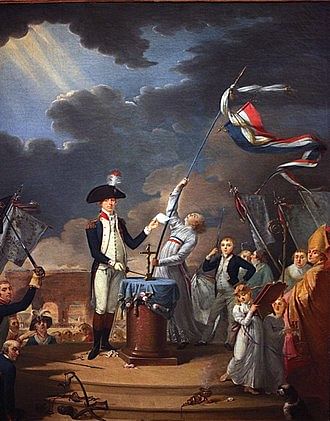
On 20 June 1791, Louis XVI and his family would escape from their home imprisonment at Tuileries. Although they were caught by the National Guard and escorted back by Lafayette himself five days later, the event made many suspicious of the marquis, since it was under the watch of Lafayette's men that the royal family escaped. Jacobin leader Maximilien Robespierre (l. 1758-1794) went so far as to name him a traitor to the people. Lafayette's reputation worsened further on 17 July, when soldiers under his command opened fire at an anti-monarchy demonstration at the Champ de Mars, leaving several French citizens dead. Following the massacre, a mob attacked his home and attempted to harm Adrienne, who managed to escape. Lafayette resigned from his command in October, after a constitution had been ratified.
By 1792, revolutionary fervor had swept France into war with Austria and Prussia. Lafayette was given command of one of the new armies raised, but he soon became wary of his new position. Jacobin power had been growing, and many of Revolutionary France's new soldiers were untrained Jacobins who hated their superior officers. Lafayette's mistrust of the Jacobins led to Robespierre to again call him a traitor in front of a mob, which burned him in effigy. Lafayette fled to the Austrian Netherlands, hoping to gain passage to the United States from there. However, he was intercepted by Austrian soldiers and placed under arrest. The monarchs of Austria and Prussia viewed him as a dangerous revolutionary, who should be imprisoned until a restored king of France could pass judgment, and he was therefore transferred to the prison of Olmütz, where he would spend the remainder of the French Revolution. In September 1797, after five years of imprisonment, his release was finally negotiated by Napoleon Bonaparte (l. 1769-1821), and he eventually returned to France.
Later Years
Following his release, Lafayette spent the next few decades out of the public eye, in his home of La Grange. Although his son, George Washington Lafayette, briefly served in Napoleon's army, Lafayette himself disapproved of the emperor and played little role in national affairs for the duration of Napoleon's reign as well as the Bourbon Restoration that followed. In 1824, Lafayette was invited by President James Monroe (l. 1758-1831) to embark on a grand tour of the United States to commemorate the country's 50th anniversary. He accepted, visiting each of the 24 states, and was received by great fanfare and adoration wherever he went.
When he returned to France, Paris was again in unrest. The new king, Charles X (r. 1824-1830), intended to restore an absolute monarchy and had placed many restrictions on civil liberties. In July 1830, a new revolution swept through Paris, with the 73-year-old Lafayette appointed as commander of a restored National Guard. Upon Charles' abdication, Lafayette threw his weight behind Louis-Philippe (r. 1830-1848) as the next king. Standing upon a balcony, Lafayette presented the new king with a tricolor flag, charging him to uphold the constitution.
Lafayette died at age 76 on 20 May 1834. He was buried beside his wife at the Picpus Cemetery, with soil from Bunker Hill sprinkled over his grave.


